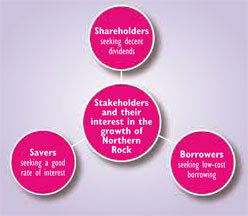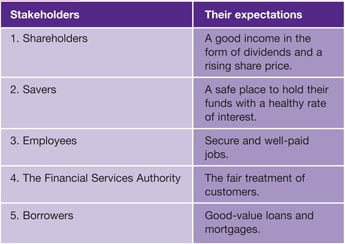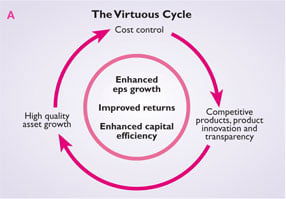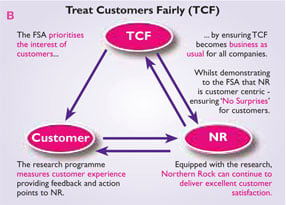
Northern Rock is the eighth largest bank in the UK by market capitalisation. In other words the value of the shares in the business. Its main business is residential mortgage lending. It also carries out other lending activities, such as commercial and personal lending. In addition it offers insurance protection, in conjunction with its insurance partners. On the funding side of the business, Northern Rock offers its customers a competitive range of savings accounts.
Northern Rock became a public limited company (PLC) in 1997, meaning that anyone can buy shares. The shares are listed on the Stock Exchange. One of the reasons for going public was to raise more capital for growth. The banking industry is competitive and large businesses have a strong advantage.

Growth is therefore an extremely important strategy. The chart shows the growth in the total assets of Northern Rock since it went public – giving a good picture of the expansion of the business.
People who want to keep their savings secure and earn a competitive rate of interest deposit them with Northern Rock. These funds, along with funds generated through other means, can then be used to lend to people who want to invest in property (or to borrow for other reasons). People saving money with Northern Rock in savings accounts (retail funding) is of course one very important part of its funding strategy.
Northern Rock also raises major volumes of funds through:
- securitisation
- covered Bonds
- wholesale (treasury raised) funds.
These are different and more complex concepts but are just as critical in the generation of funds to lend to its borrowers.
Typical borrowers will be people wanting to move home. These may be families wanting a bigger house, people who want to take out a new loan with a better interest rate (re-mortgaging) and some people wanting to buy their first home.
Savers receive interest and borrowers pay back their loans with interest. The type of loan taken out to buy property is usually a mortgage. Mortgage repayments are typically based on a long-term (about 20 years) period, but many people remortgage at a much earlier stage (about 3-5 years) and try to get a better rate of interest. The mortgage is repaid with interest and is secured against the property. It is called a secured loan because if the borrower runs into trouble, the property may have to be sold to repay the loan, although this is only in extreme cases.
This case study shows how Northern Rock’s strategy (plan) is to keep growing. It is successful in this because it:
- focuses on what it does best
- has lower costs than rivals
- gives a top priority to the needs of customers
- is well managed.

Northern Rock’s shareholders have put funds into the business by buying shares and in return they receive an income in the form of dividends, which is their share of the profits. There are therefore three main stakeholder groups who have an interest in Northern Rock’s growth:
Company growth

All organisations need to have objectives – the end purposes the organisation seeks to achieve. For example, a common business objective is to make a profit. Northern Rock’s main objectives are to grow profitably, drive down costs to improve cost efficiency, and delivering a good return for shareholders.
By expanding profitably, it is best placed to give its customers what they want – high-quality service. There are a number of ways in which a business can grow.
External/inorganic growth
A business can develop by taking over or joining together with other businesses. For example, Cadbury Schweppes was formed from the merger (joining together) of Cadbury (a British confectionery manufacturer) and Schweppes (an American soft drinks manufacturer). Northern Rock could therefore grow by buying another financial services company.
Internal/organic growth
This takes place when a business ploughs back large parts of its profit into expansion. This is the chosen route for Northern Rock. Profits are ploughed back into new buildings, developing better Information Technology Systems, training staff and expanding the business in other ways.
As it matures, it is possible to make more and more loans. Northern Rock therefore grows like a snowball. With each turn, the company becomes bigger and more profitable to the benefit of all the stakeholders.
Goals and strategies
Organisations need to have goals to work towards. We can think of the goal as the end to be achieved. The strategy is the means to achieve this goal.

For Northern Rock, the:
- goal is a high-growth target
- strategy is to achieve growth through having a low cost base
- strategy consists of a number of elements that enable the business to achieve high growth.
Components of this strategy include:
- ongoing investment in important resources – people (for example, by providing training and well-paid career paths), buildings and systems (including IT systems)
- developing means of dealing with customers – for example, through Northern Rock branches, post, telephone and e-commerce
- raising funds in different ways including from personal accounts (people like you and me), from commercial markets across the world and potentially, the option of selling more shares in Northern Rock.
In recent years, Northern Rock has been able to gain an increasing amount of funds from these sources, making the growth strategy possible as lending has steadily increased.
A useful parallel is to think of a highly efficient manufacturing company. Such a company would produce goods – for example, cars or chocolate bars – at a lower cost than rivals, whilst still giving customers the types of cars or chocolate they want. This is how Northern Rock has been able to grow so quickly. It is efficient, well managed and has lower costs than its rivals and is therefore able to lend money to borrowers at a relatively low interest rate.
Strategies and stakeholders

For a strategy to be successful it needs to be:
- Feasible. Northern Rock needs to have the right resources, in particular the funds. We have already seen that the company has the resources to support growth.
- Acceptable for the stakeholders. Different stakeholders will have varying expectations, as shown in the table.
Northern Rock is the lowest cost producer in the banking industry in Europe. A key advantage over rivals is that its Head Office and key operational units are located in the north east of England where wages are, on average, lower than in the rest of the UK.

The cost of living is much lower in this area, so people are able to enjoy a high standard of living even though income may be lower. Northern Rock is then able to pass this advantage of low costs to its customers. It is one of the reasons customers are so loyal to the company. All of this leads to a virtuous cycle of benefits enjoyed by all the stakeholders.
Shareholders benefit in two ways from having shares in a company:
- In the form of dividends. For many people, these are an important source of income. For example, pensioners may invest a lump sum that they receive on retirement in shares. As Northern Rock is profitable, it has been able to pay out healthy dividends.
- When share prices rise. This is an example of a capital gain. Because Northern Rock is profitable and growing, the share price has risen.
Savers also benefit from the growth of Northern Rock. Because of its low cost base and high profits, it is able to pay savers a good rate of return. It is thus a competitive place to save money.
Employees benefit from the company’s growth, as the success of the business makes their jobs secure. Growth provides more opportunities for promotion, coupled with good wage rates. Northern Rock employees are also able to enjoy and share in the success of the company through employee share schemes.

Customers – The Financial Services Authority is responsible for regulating the financial services industry. It is particularly concerned about making sure that customers’ needs are looked after. For example, it is essential that customers are clear about the products and charges they are being offered. The FSA has set out that customers must be treated fairly and reasonably. This applies to all aspects of the relationship between firm and customer, including customer complaints. Northern Rock is committed to these principles and believes that ‘customers must be fairly treated in all of our business’ and undertakes customer research to establish this is happening.
Borrowers benefit from the efficiency of Northern Rock. For example, they are able to get a variety of low-cost, value-for-money mortgages. These are supported by a range of other services, such as good-quality household insurance and life assurance, if required. In addition, borrowers can take out loans for refurbishing and improving their property.
Communicating with stakeholders
It is not enough to have a winning strategy; it is also important to communicate what you are doing. There are a number of ways in which an organisation can communicate.

One approach would be a top-down method where messages are sent by a company to its stakeholders – shareholders, employees and customers – with no possibility for feedback. Communication would flow along a chain from the sender to the end receiver.
Northern Rock rarely operates in this way. It believes in multi-channel, multi-directional communication with stakeholders. In other words, it uses many different methods in which to impart information. For example, for shareholders this would be:
- through the post (annual report, notices)
- online (website)
- in face-to-face meetings (Annual General Meeting)
- on the telephone (dealing with queries).
By encouraging shareholders and other stakeholders to provide feedback communication, Northern Rock is best placed to give them what they want.
For example, independent market research shows levels of satisfaction are so high that over 85% of Northern Rock’s customers would recommend it to their relatives or friends.
Conclusion

Northern Rock provides a good example of a growth strategy within a company. The key driver enabling growth is having a low cost base. This allows Northern Rock to generate high profits and to expand its asset base.
By working closely with stakeholders, and delivering its goals, the company has been able to give customers good products and service and employees good job opportunities and working conditions. Overall, this leads to an ongoing cycle of expansion.
